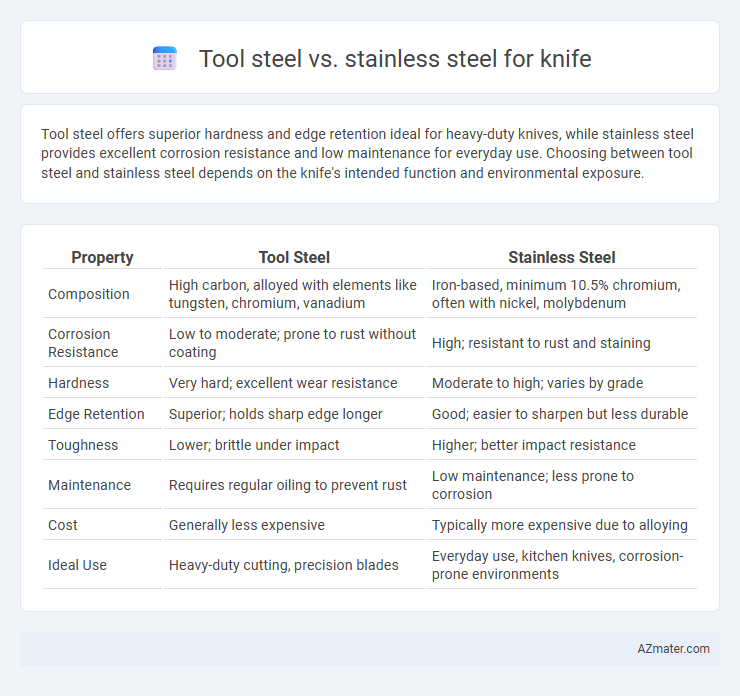Tool steel offers superior hardness and edge retention ideal for heavy-duty knives, while stainless steel provides excellent corrosion resistance and low maintenance for everyday use. Choosing between tool steel and stainless steel depends on the knife's intended function and environmental exposure.
Table of Comparison
| Property | Tool Steel | Stainless Steel |
|---|---|---|
| Composition | High carbon, alloyed with elements like tungsten, chromium, vanadium | Iron-based, minimum 10.5% chromium, often with nickel, molybdenum |
| Corrosion Resistance | Low to moderate; prone to rust without coating | High; resistant to rust and staining |
| Hardness | Very hard; excellent wear resistance | Moderate to high; varies by grade |
| Edge Retention | Superior; holds sharp edge longer | Good; easier to sharpen but less durable |
| Toughness | Lower; brittle under impact | Higher; better impact resistance |
| Maintenance | Requires regular oiling to prevent rust | Low maintenance; less prone to corrosion |
| Cost | Generally less expensive | Typically more expensive due to alloying |
| Ideal Use | Heavy-duty cutting, precision blades | Everyday use, kitchen knives, corrosion-prone environments |
Introduction: Tool Steel vs. Stainless Steel Knives
Tool steel knives offer superior edge retention and toughness, making them ideal for heavy-duty cutting tasks and prolonged use. Stainless steel knives resist rust and corrosion, providing low maintenance and excellent hygiene for everyday kitchen applications. Choosing between tool steel and stainless steel depends on balancing durability, sharpness, and corrosion resistance requirements.
Key Properties of Tool Steel for Knives
Tool steel for knives offers exceptional hardness and edge retention due to its high carbon content and alloying elements like chromium, vanadium, and molybdenum. This steel type excels in toughness and wear resistance, making it ideal for heavy-duty cutting tasks and prolonged use. Unlike stainless steel, tool steel requires more maintenance to prevent corrosion but provides superior sharpness and durability essential for professional-grade knives.
Key Properties of Stainless Steel for Knives
Stainless steel for knives is prized for its excellent corrosion resistance, which ensures durability and low maintenance even in humid or wet environments. High chromium content in stainless steel alloys enhances hardness and edge retention, making it ideal for precise cutting tasks. Additionally, stainless steel offers superior stain resistance and often requires less frequent sharpening compared to tool steel, making it a popular choice for kitchen and everyday knives.
Edge Retention Comparison
Tool steel knives exhibit superior edge retention due to their higher carbon content and ability to be heat-treated for increased hardness, allowing the blade to maintain sharpness longer under rigorous use. Stainless steel knives, while offering better corrosion resistance, typically have lower hardness levels, resulting in faster edge dulling during heavy or frequent cutting tasks. Selecting tool steel is ideal for applications demanding prolonged sharpness, whereas stainless steel suits environments prioritizing rust resistance over edge longevity.
Corrosion Resistance: Which Performs Better?
Stainless steel outperforms tool steel in corrosion resistance due to its high chromium content, typically above 10.5%, which forms a passive oxide layer protecting the blade from rust and stains. Tool steel contains lower chromium levels and often relies on surface coatings or regular maintenance to prevent corrosion, making it less ideal for humid or wet environments. For knife applications where resistance to moisture and acids is critical, stainless steel offers superior durability and longevity.
Ease of Sharpening
Tool steel offers superior ease of sharpening due to its simpler alloy composition and lower hardness compared to stainless steel, which often contains higher chromium content making it more corrosion-resistant but harder to sharpen. The abrasive resistance of stainless steel demands more frequent professional sharpening and specialized tools, while tool steel blades maintain edge retention with less effort and time during routine sharpening. For users prioritizing effortless maintenance and quick edge restoration, tool steel knives provide a significant advantage in sharpening convenience.
Toughness and Durability
Tool steel exhibits superior toughness due to its high carbon content and alloying elements like chromium, vanadium, and molybdenum, which enhance wear resistance and edge retention in knife blades. Stainless steel offers excellent corrosion resistance because of its chromium-rich composition but may sacrifice some toughness compared to high-grade tool steels, making it less resistant to chipping under heavy use. For knives requiring maximum durability and impact resistance, tool steel is preferred, while stainless steel is ideal for environments where rust prevention is critical.
Maintenance Requirements
Tool steel knives require frequent oiling and drying after use to prevent rust and corrosion due to their high carbon content, while stainless steel knives offer superior corrosion resistance and demand less rigorous maintenance. Maintaining tool steel involves regular sharpening and rust prevention treatments, as they are prone to oxidation in moist environments. Stainless steel knives typically only need basic cleaning and occasional honing, making them more suitable for users seeking low-maintenance blades.
Best Uses and Applications
Tool steel offers superior hardness and edge retention, making it ideal for high-performance knives used in precision cutting, woodworking, and heavy-duty tasks requiring durability and resistance to wear. Stainless steel excels in corrosion resistance and low maintenance, making it the preferred choice for kitchen knives, outdoor applications, and environments where moisture exposure is frequent. Choosing between tool steel and stainless steel depends on the knife's intended use, with tool steel favored for long-lasting sharpness and stainless steel for ease of care and rust prevention.
Choosing the Right Steel for Your Knife
Selecting the right steel for your knife depends on usage, maintenance, and performance needs. Tool steel offers exceptional edge retention and toughness, ideal for heavy-duty tasks, while stainless steel provides superior corrosion resistance, making it suitable for wet or outdoor environments. Consider the balance between durability, sharpness, and rust resistance to match the steel type with your specific cutting requirements.

Infographic: Tool steel vs Stainless steel for Knife
 azmater.com
azmater.com